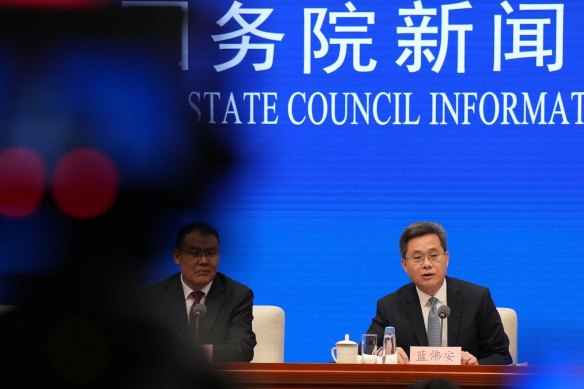
The Ministry of Finance’s briefing might have provided only an outline of Beijing’s plans, but that was sufficient to stabilise the sharemarket, which rose 1.9 per cent on Monday.
Attention will now turn to the next National People’s Congress (NPC), due either late this month or very early next month. If there is to be a big spending package, the NPC would have to authorise it, which probably explains why the weekend briefing was so short of detail.
Loading
The flurry of activity from Beijing’s economic agencies in the past few weeks reflects a sense of urgency in response to signs that China’s economy is faltering, which economic data released on Monday tends to confirm.
China’s consumer price index rose only 0.4 per cent last month, year-on-year, down from 0.6 per cent in August, with non-food price inflation negative. “Core” inflation, which excludes volatile food and energy prices, was only 0.1 per cent.
Factory-gate prices fell 2.8 per cent in September, year-on-year, accelerating from the 1.8 per cent decline in August. Producer prices have now been falling steadily for two years, with last month’s fall the biggest of the past six months.
The value of China’s exports grew by 2.4 per cent last month, but that was way short of the 8.7 per cent growth experienced in August despite double-digit growth in export volumes.
That discrepancy points to the degree of overcapacity in China’s factories, the lack of domestic demand and the increasing protectionism China is facing from trade partners unsettled by the flood of cheap imports entering their markets.

China’s finance minister Lan Fo’an gave little details about the government’s stimulus plans.Credit: Bloomberg
Lan’s comments at the Ministry of Finance briefing hinted that, when the fiscal stimulus package is unveiled, it could be quite large and include spending beyond the narrow areas he referred to.
“Our countercyclical adjustment goes far beyond what I have mentioned,” he said, adding that the scope of the spending was still being discussed.
“The central government, when it comes to increasing the deficit and increasing debt, we have significant room.”
Loading
The consensus among external economists seems to be that Beijing will unveil stimulus of about 2 trillion yuan (about $420 billion), which should be enough to stabilise the economy and perhaps enable it to achieve its targeted growth of “around 5 per cent” for this year, but probably not much beyond that.
A respected Chinese media outlet, Caixin, however, reported late on Monday that China may raise 6 trillion yuan (about $1.25 trillion, or roughly 4.5 per cent of GDP) from ultra-long special government bonds over three years, partly to help local governments reduce their debts.
In the absence of major government spending to boost household spending, it would appear that Xi Jinping is sticking with his strategy of shifting the focus of economic policy to support investment in advanced technologies and advanced manufacturing, both to achieve sustainable long-term economic growth and to insulate China from the increasing protectionism in the West.
While the strategy, and the excess supply it is producing, is deflationary, it is driven by the geopolitical backdrop, China’s past experience and Xi’s own convictions.
In 2008, in response to the global financial crisis, China embarked on a massive stimulus program – about 4 trillion yuan, or more than 12 per cent of its GDP at the time.
That spending on infrastructure and housing has left a legacy of massive over-investment in infrastructure and property, and the boom and bust in apartment construction that is at the heart of China’s and its local governments’ economic and financial challenges today.
Past stimulus, notably in 2015, has also inflated sharemarket bubbles, which have subsequently burst.
Under Xi, Beijing’s control of the economic levers has tightened and the shift of government favour and investment towards the sectors he has prioritised – which, to date, hasn’t included households’ consumption – has been pronounced.
Loading
Crackdowns on a series of private business sectors have also damaged confidence and shrunk activity in the sectors that have been responsible for a disproportionate share of China’s growth over the past half-century.
While senior officials have tried to reassure private businesses that they will now be treated equally with their state-owned or controlled counterparts, the macro settings of overcapacity, shrinking (or non-existent) profit margins and weak domestic demand aren’t conducive to a big private sector rebound.
In any event, that doesn’t seem to be what Xi wants.
He appears to be want to stabilise China’s annual growth at around the 5 per cent mark and avoid deflation. At the same time, he’s looking to shift growth drivers away from consumption and speculative investment in property and infrastructure and towards investment that seeks to deliver technology leadership in strategic sectors, while reducing China’s exposure to, and reliance on, other economies.
The Business Briefing newsletter delivers major stories, exclusive coverage and expert opinion. Sign up to get it every weekday morning.



























